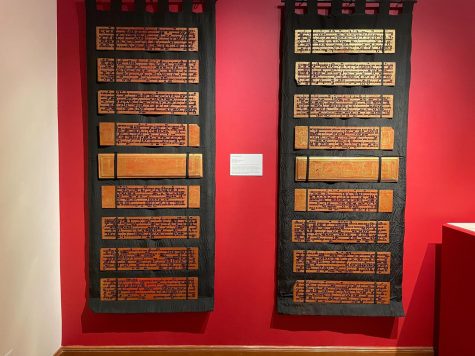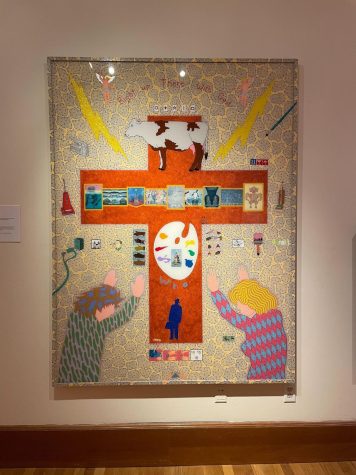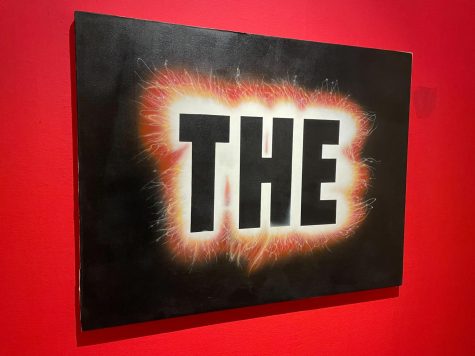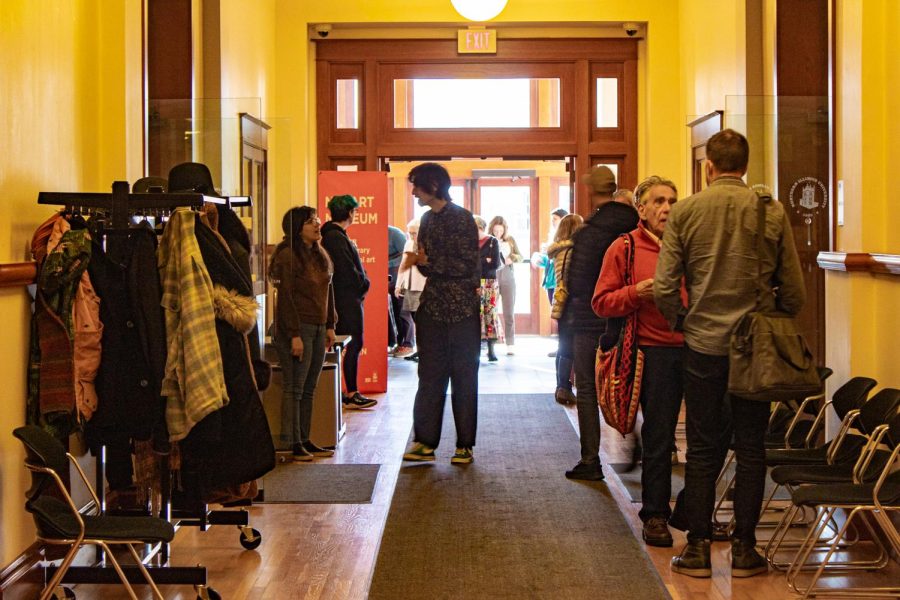NIU art exhibits bring together the old and new
The hall outside of the NIU Art Gallery full of people talking. The Gallery opened Wednesday for a public reception. (Cheyanne Quintanilla | Northern Star)
April 3, 2023
The new art exhibits at the NIU Art Museum offer an engaging exploration of historical and contemporary artistic expressions, encompassing both global and regional perspectives.
A public reception was hosted Wednesday at the NIU Art Museum, located in Altgeld Hall.
The two-hour reception was split between two exhibits — “Americans in Burma: The Art of Collecting” and “Local Visions II” — along with an informal talk and walkthrough of the galleries with curators Michael Bennett, Peter Olson and Catherine Raymond.
“Americans in Burma: The Art of Collecting” focuses primarily on Burmese and Buddhist pieces donated by several Americans who traveled to Burma between the 1950s and the 1990s, including Helen Trager and Richard M. Cooler.
The exhibition highlights the significance of protecting historical artifacts and imparting their lessons to future generations. Specifically, it explores how these artifacts reflect the culture of their respective eras, and how those cultures have evolved over time.
Some of the most notable pieces included a massive Burmese manuscript called a “Kammawasa,” a massive golden tapestry depicting Buddhist narrative scenes, a Buddhist altar and a set of Burmese orchestral instruments.

Catherine Raymond, the director of the Center for Burma Studies, explained each piece in depth and displayed how Americans played a major supporting role in the art of each respective culture. One of the pieces that Raymond discussed was a painting of Myanmar’s Yangon Sule Pagoda by Aung Win.
“Outside of the Buddha’s role, the art was usually done as an act of devotion and the act of devotion was really new to painting manuscripts, temples and paintings for funeral purposes,” Raymond said. “The moment the Europeans arrived and Americans particularly, they started supporting the artist.”
“Local Visions II” showcased a number of personal art collections by local DeKalb and Sycamore residents. Most of these paintings are usually made with whatever scraps the artist may have on them.
One example of this is the piece “I Worked Here” by Michael Lash. The piece is a simplistic drawing of an older gentleman on butcher block paper with blue and green paint streaks all over. Above him are the words “Someone should steal it” and “Why would anyone put this on the wall?” written in English.
Another piece that was eye catching was “Right up There with God” by Lee Grantham, created in 1986 and from the collection of NIU graduate Ari Norris, a sculpture studio art major. The piece was made entirely with acrylic paint, glitter and postcards.

Norris’ collection was arguably the most interesting of all, including one unnamed piece by Helmut Hammen which is aptly nicknamed “THE.” The painting itself is a simple black background with the simple word “THE” front and center shooting out sparks. Genius!

NIU’s Art Museum did a fantastic job showing off these wonderful pieces from the past and present for all to see. The exhibit goes on to prove that humans don’t just collect art because it’s cool; we collect art because it tells us so much about the integrity and creativity of those who came before us, and what we stand to learn from them.
The NIU Art Museum is located in Room 116 of Altgeld Hall. The exhibits will be shown from March 30 to May 13, and the gallery is open for viewing from 10 a.m. to 1 p.m. Tuesdays and Wednesdays, noon. to 6 p.m. Thursdays and Fridays and noon to 3 p.m. on Saturdays.



